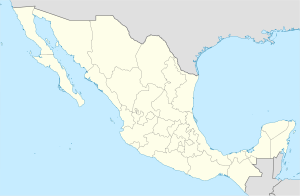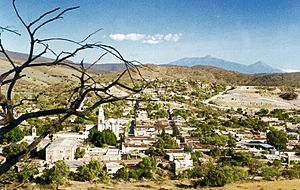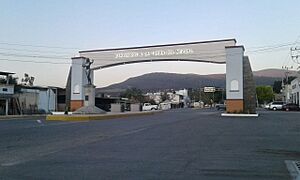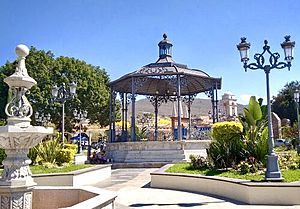Tonaya facts for kids
Quick facts for kids
Tonaya
|
|||
|---|---|---|---|
|
Municipality and town
|
|||
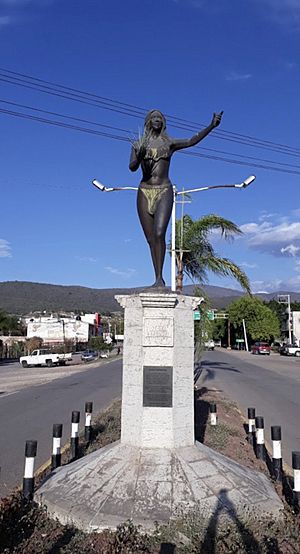
La Diosa del Agave, Tonaya, Jalisco, México
|
|||
|
|||
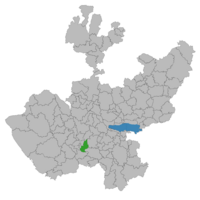
Location of the municipality in Jalisco
|
|||
| Country | |||
| State | |||
| Founded | March 13, 1825 | ||
| Founded as | Al oriente donde sale el sol | ||
| Municipal status | 1825 | ||
| Government | |||
| • Type | Democratic Republic | ||
| Area | |||
| • Municipality | 293.6 km2 (113.4 sq mi) | ||
| • Town | 1.81 km2 (0.70 sq mi) | ||
| Population
(2020 census)
|
|||
| • Municipality | 5,961 | ||
| • Density | 20.303/km2 (52.585/sq mi) | ||
| • Town | 3,706 | ||
| • Town density | 2,048/km2 (5,303/sq mi) | ||
| Demonym(s) | Jalisciense, Tonayense | ||
| Time zone | UTC-6 (Central Standard Time) | ||
| • Summer (DST) | Central Daylight Time | ||
| Area code(s) | 343 | ||
| Website | http://www.tonayajalisco.gob.mx | ||
Tonaya is a town and municipality located in Jalisco, a state in central-western Mexico. It's a place with a rich history and a strong sense of community. The municipality covers an area of about 293.6 square kilometers.
As of 2020, the total population of the Tonaya municipality was 5,961 people. The town of Tonaya itself is home to 3,706 residents.
Contents
- A Look Back at Tonaya's History
- Tonaya's Landscape and Nature
- How Tonaya Makes a Living
- Tonaya's Rich Culture
- Buildings and Landmarks
- Exploring Tonaya
- Learning in Tonaya
- Daily Needs and Shops
- Sports and Fun Activities
- Homes in Tonaya
- Community Services
- Connecting with the World
- Getting Around Tonaya
- Towns and Villages in Tonaya
- Images for kids
A Look Back at Tonaya's History
Tonaya has a long history, going back to before the Spanish arrived. It was founded by tribes of Toltec origin. The first town was located east of where it is now, on some hills. Its founders were brave people like Otomín, Tlatoli, Tzomitloc, and Tlayomich. They worked together with other natives to settle the region.
Many early settlers faced challenges, but the survivors chose Tzomitloc (also called Amole) as their leader. Tonaya was part of a larger area called the cacicazgo of Tuxcacuesco. This area was then part of the province of Amole, which stretched from the volcanoes of Colima to the beaches of Barra de Navidad.
In 1523, Spanish armies led by Alonso de Ávalos took control of this region. In his honor, the area became known as the Province of Ávalos.
By 1825, Tonaya had its own town hall. It included several large farms and ranches like Higueras, Coatlán, and Santa Gertrudis. Tonaya officially became a municipality before 1837. Its borders with the nearby municipality of Tuxcacuesco were set in 1911.
Religious Heritage
Tonaya is known for its strong Catholic faith. The church of Nuestra Señora de la Asunción (Our Lady of the Assumption) was built in the 1800s. Even today, its old bell tower stands tall, showing its historical importance. For 200 years, it was the tallest building in Tonaya.
A special story in Tonaya is about La Virgen de Tonaya (The Virgin of Tonaya). People believe she protects the town. Her spirit is said to live in a doll inside the church. Every year, this doll is carried through the streets for everyone to see during a special celebration.
Tonaya's Landscape and Nature
The land in Tonaya is made up of hills and plains. The rocks here were formed a very long time ago, during the Cretaceous period. They include limestone, granite, and other types of rocks.
Most of the municipality has hills that are part of the Tapalpa mountain range. There are also semi-flat areas with subtropical plants. A small part of the land is flat, sitting about 900 to 1,000 meters above sea level.
How Tonaya Makes a Living
Tonaya's economy relies on several key activities. These include farming, raising animals, and small industries.
- Agriculture: About 44.4 square kilometers of land are used for farming. Farmers grow crops like corn, beans, sorghum, and agave.
- Cattle Raising: People raise cattle for meat and milk. They also raise pigs, sheep, goats, and chickens.
- Industry: "Las Tabernas" is a place where mezcal, a type of alcoholic drink, is made. There's also a growing furniture industry.
- Forestry: Oak trees from the forests in the northern and eastern parts of the municipality are used for wood.
- Mining: Tonaya has deposits of gold, silver, and copper. Non-metallic minerals like lime, plaster, and marble are also found.
- Fishing: People fish in the Tonaya River for jackal, crappie, and catfish.
- Commerce and Services: There are many small and medium-sized shops that sell food and other goods. Professional, technical, and tourism services are also available.
Tonaya's Rich Culture
Tonaya has a vibrant culture with many interesting traditions and artistic expressions.
Ancient Discoveries
East of the town, you can find the remains of the old pre-Hispanic town of Tonaya. There are even ruins that might have been a "cue," which is a type of ancient shrine.
Important Monuments
In Tonaya, you can see five bronze statues. They honor important figures like Benito Juárez and Miguel Hidalgo. One special statue is called "La Diosa del Agave" (The Goddess of Agave), located at the town's entrance.
Welcoming Visitors
At the entrance to Tonaya, there's a welcome sign that says "Bienvenidos a la tierra del Mezcal." This means "Welcome to the Land of Mezcal." The "Diosa del Agave" statue stands proudly in front of it.
Art and Creativity
Tonaya has inspired many artists. José Antonio Michel wrote "El Quijote Huehuenche" and "Versos Picarescos." José Trinidad Lepe Preciado wrote a series of stories.
Inside the Town Hall, there's a beautiful mural dedicated to Justice. It was created by Professor Amador Toscano Quintero in 1996.
Sounds of Tonaya
Music is important in Tonaya. José Antonio Michel composed songs like "Luna de Octubre." The song "Viva Tonaya" was written by Alvaro Velasco. Recently, the Coatiacillo mariachi band and Tonaya's Banda los Aventureros have become popular.
Handmade Treasures
Local artisans create many beautiful items. These include:
- Craft and cross-stitch work.
- Huaraches (traditional sandals).
- Wood articles.
- Saddlery (saddles and leather goods).
- Raw leather soguillas (ropes).
- Pouches, chiquigüites (baskets), and otate hats.
Special Clothes
The "unraveled charro suit" is a traditional costume unique to Tonaya. It is made with artistic details.
Delicious Food and Drinks
Tonaya offers a variety of tasty foods and drinks:
- Food: Try kid's goat, white pozole (a type of soup), shrimp tacos, pipían (a sauce), carnitas (fried pork), chicharrones (pork rinds), tamales, sopitos (small tortillas), and tostadas (crispy tortillas).
- Sweets: Enjoy candied pumpkins, plums, and guava. There are also garapiñados (candied nuts) and borrachitos (small cakes).
- Drinks: Popular drinks include mezcal, pulque (a fermented drink), atole (a warm corn-based drink), and fruit drinks made from pomegranate, guayabilla, tamarind, and myrtle.
Fun Festivals and Traditions
Tonaya celebrates several important festivals throughout the year:
- January 15: A special celebration for the coronation of the Virgin of Tonaya.
- March 19: The festivity dedicated to San José.
- August 6 to 15: Celebrations in honor of Our Lady of the Assumption.
- Other local celebrations include January 24 in Coatlancillo, January 10 in El Cerrito, November 12 in Los Asmoles, and December 12 in the Guadalupana colony.
Buildings and Landmarks
Tonaya has several important historical buildings, especially religious ones.
- The Church of Our Lady of the Assumption in the town center.
- The Temple of Our Lady of Peace in Coatlancillo, built in a Colonial style.
- The Temple of Santa Gertrudis, which dates back to the eighteenth century and is the oldest in the municipality.
The main plaza in the center of Tonaya, next to the Church of Our Lady of the Assumption, has been recently updated with a beautiful garden.
The House of Culture "Dr. Mónico Soto" opened in 2007. It's a place where people can enjoy activities like dance, singing, music, exhibitions, and lectures.
You can also see the old ruins of haciendas (large estates) like Coatlancillo and Coatlán. Some, like Refugio, Los Yugos, El Paso, and Tenango, are still in good condition.
Exploring Tonaya
Tonaya offers natural beauty and historical sites for visitors. You can explore the forests in the northern and eastern parts of the municipality. The old haciendas like Coatlancillo, Las Higueras, and El Paso de San Francisco are also interesting places to visit.
Learning in Tonaya
Tonaya provides educational opportunities for its young residents. In the 2004-2005 school year, the municipality had:
- 2 preschool centers.
- 2 primary schools.
- 1 secondary school.
- 1 high school.
- 1 education school.
Daily Needs and Shops
The community's daily needs are met by various grocery stores and retail shops located throughout the municipality.
Sports and Fun Activities
Tonaya has facilities for sports and recreation. The Unidad Deportiva de Tonaya is a sports center with areas for:
- Baseball
- Soccer
- Volleyball
- Basketball
- Athletics
- Children's games
For culture and fun, there are also civic plazas, gardens, a cinema, a library, and recreational centers.
Homes in Tonaya
Tonaya has a total of 1,454 homes. On average, about 3.82 people live in each home. Most homes are built with sturdy materials like roof tiles, adobe, or block walls.
Community Services
The municipality provides many important services to its residents. These include:
- Public lighting
- Markets
- Parking
- Cemeteries
- Roads
- Public restrooms
- Public safety and traffic services
- Parks and gardens
- Sports centers
Most homes have basic services:
- 97.8% have drinking water.
- 90.8% have sewerage (wastewater systems).
- 98.3% have electricity.
Connecting with the World
Tonaya has various ways for people to communicate and stay connected. These include mail, telegraph, telephone, fax, radio, and television signals.
Getting Around Tonaya
You can travel to Tonaya by land using highway number 54 and highway number 80. These highways connect to other towns like El Grullo and Unión de Tula. You can get there by direct buses or private vehicles. Within the municipality, people use rental cars and private vehicles to get around.
Towns and Villages in Tonaya
The municipality of Tonaya is made up of 58 different places, called localities. 29 of these localities have people living in them, while 29 are unoccupied.
The most important inhabited localities are:
- Tonaya (the main town)
- Coatlancillo
- El Cerrito
- Las Amoles
- La Liebre
The 29 inhabited localities are: Alpizahua, Amacuautitlán, Atarjeas de Covarrubias (San Isidro), Coatlancillo, Coatlán, Coyotomate, El Cerrito, El Convento, El Paso de San Francisco, La Casita, La Cofradía, La Piña, Las Higueras, Las Liebres (La Liebre), Las Playas, Los Asmoles, Rancho Los González, Metapan, Ojo de Agua, Rancho de Reinaldo Michel, Rancho Escondido, Rancho Nuevo, Rancho RRR, San Luis Tenango (Tenango), San Rafael, Santa Gertrudis, Tecomatlán and Tonaya.
Images for kids




